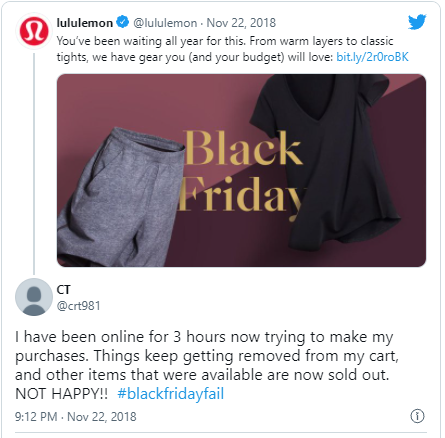Brands and retailers are about to enter one of the most crucial periods of the year. Holidays account for 19% of retail sales, which can reach 25% if you include gifting categories like jewelry, apparel, toys, and electronics. Much of these sales originate online. Data shows that consumers spent more than USD 188.2 billion online in 2020, up 32% from 2019. Given the high stakes, a haphazard website during this time could result in missed opportunities and revenues.
A glitch or outage is likely to occur on e-commerce platforms during critical sales days like Black Friday or Cyber Monday. Examples include:
- Best Buy suffered a website outage on Black Friday in 2014
- High traffic slowed down Target’s website on Cyber Monday and Neiman Marcus on Black Friday in 2015
- Macy’s site crashed for the same reason on Black Friday in 2016
- Both Macy’s and Lowe’s site experienced technical glitches on Black Friday in 2017
- Amazon’s website crashed on Prime Day in 2018
- Costco’s website went down on Thanksgiving in 2019
- Adidas, ToysRUs, H&M, Lululemon and Macy’s all experienced outages during peak periods in 2020
- Amazon suffered another worldwide outage that lasted nearly two hours, impacting 38,000 shoppers on its website and mobile app on Prime Day July 11, 2021.
Poor holiday website performance is extremely costly and the above examples prove that not even the biggest e-commerce stalwarts can be immune to them. Such occurrences cause businesses to lose not just sales but even customers in just a few seconds of downtime.
For a frictionless shopping experience, we’ve compiled a performance checklist of website optimization to ensure your business can take advantage of every sale.
1. Check the SEO score of your website
Apart from the customary research for season keywords and digging through Google Analytics and Search Console data for popular holiday voice searches here are some of the most effective ways of improving your website’s SEO score:
Simplify your site architecture
Draw from past insights and competitor research
Given the fierce competition of today, you should evaluate which keywords, landing pages, and campaigns worked for you last holiday season. Also, conduct a competitive analysis to understand the successes and failures of your peers. Tools like SEMrush and MOZ can help uncover which keywords your competitors are ranking for on paid and organic search.
Employ a combination of SEO and CRO
SEO drives shoppers to your site and CRO or Conversion Rate Optimization helps you nudge them further into the sales funnel. Despite an uptick in website traffic to e-commerce stores in 2020, conversions decreased by 2% YoY, underscoring the need to employ conversion rate optimization tactics. CRO is a methodology that involves various checks like heatmaps to analyze how shoppers engage with your site, A/B testing your high-value landing pages, user recordings – that basically records a visitor’s journey on your site, etc. Insights from such studies help further refine your holiday website performance to drive more targeted conversions.
Work to get backlinks
Develop link-worthy assets like ‘Stocking stuffer gift guide’ or ‘The ultimate lockdown party ideas 2021’. Affiliates can use these to promote your products as good holiday gifts, or write guest blogs for niche categories. You could also check if there are any complementary brands willing to collaborate for cross-platform promotions. Top results on Google’s first SERP have 3.8 times more backlinks than those below them. Therefore, the more backlinks you create the better it is for your website’s visibility.
Holiday-specific landing pages
Optimize pages for those products that are more likely to be given as gifts. Instead of creating new seasonal pages every year, it makes sense to reuse them with a few trend-based tweaks. If you create a dedicated page for email marketing, ensure it is tied into your current navigation or redirected to the most relevant page once the sale or event has ended.
2. Make sure your site loads quickly
By taking basic optimization measures, you can measure and increase the page speed of your website. To steer clear of mishaps, Google’s Page Speed Tool is worth including in your holiday website performance checklist. It helps keep a constant pulse of your website speed and highlights aspects that can be improved. Besides that, here are some effective measures you can take to improve your website’s load time:
- Minimize the number of JavaScript and CSS (Cascading Style Sheets) files. This means removing unnecessary characters and coding thus improving JavaScript
- Use website caching wherever feasible. This stores a page’s content on the shopper’s device for sometime, enabling quicker and more seamless page loads.
- Optimize image file size without altering its quality. For instance, JPEG images are smaller than PNG.
- Check your website for heavy plugins
- Keep track of your server response time
- Identify and resolve 404 errors
- Implement Accelerated Mobile Pages (AMP)
- Improve visibility into where and when third parties are loading scripts on your site
Apart from this, it’s useful to have a prompt social media response strategy handy to pacify frustrated shoppers facing technical glitches.


3. Take adequate measures to enhance data security
In September 2020, malicious login attempts peaked at 84.71% as per the PerimeterX Automated Fraud Benchmark Report. A study by Forrester and Bizrate also pointed out that web application flaws and software vulnerabilities, respectively, contribute to 39% and 30% of external attacks that led to past breaches.
Savvy retailers are therefore prioritizing building security into their website development processes. Due to the increasing percentage of open source code, this is an increasingly effective tactic since most of the website development now happens outside the traditional in-house team. Data security measures that are vital and should be on your holiday website performance checklist are as follows:
Obtain Payment Card Industry Data Security Standard (PCI DSS) compliance – An independent body created by Visa, MasterCard, American Express, Discover, and JCB, the PCI Security Standards Council (PCI SSC) administers and manages the PCI DSS. E-commerce players would do well to ensure compliance by fulfilling certain requirements thus enabling an incredibly secure transaction environment for its cardholder customers.
Use multi-factor authentication (MFA), 2-factor authentication (2FA), or 2-step verification (2SV). – By integrating verification through a customer’s phone number, email address, or an authenticator app you can prevent security breaches on your online platforms.
Implement WAF (web application firewall) to prevent Distributed Denial of Service (DDoS) – A WAF like Cloudflare typically protects web applications from attacks such as cross-site forgery, cross-site-scripting (XSS), file inclusion, and SQL injection, among others. A WAF is a protocol layer 7 defense that operates through a set of rules often termed as policies. These policies act as filters protecting applications from vulnerabilities caused by malicious traffic.
Apart from these, also work on identifying and remediating any violations by third parties before the holidays.
4. Refresh your product page and website content
With each holiday season, new products and trends surface. A great way to understand your customers’ priorities this holiday season is to look up common search queries so you can answer them in your product descriptions. Help them compare similar products on the product page itself. This will help them decide on their next buy faster.
79% of shoppers say user-generated content highly impacts their purchase decisions. Ensuring you have the most helpful reviews at the top of the list will drive better brand trust. Laying out holiday-specific product visuals will help you gain a competitive edge. 3D or 360-degree product images make it easier for shoppers to view items in action and increase conversions by up to 250%.
93.8% of retailers find that upgrades to key pages like product pages are vital to increasing holiday sales. Drawing insights from holiday-based consumer trends is pivotal when refreshing the overall website and product page content. For instance, a study by SimilarWeb found that top PPC terms in 2019 were 50% branded and 50% generic. To get better noticed this holiday season, explore a combination of long tail keywords, branded keywords, and buy-intent specific keywords while refreshing your product content. Here are a few examples to get you started:
Here are a few interesting content ideas worth adding to your checklist to keep your visitors engaged and returning back:
- Gift Guides: Help people find the perfect gift in a curated collection of items.
- How-To Guide: Some thought-starters in this direction would be ‘How to set the best Thanksgiving table’, ‘How to impress guests with the best portico decorations’, or ‘How to buy gifts for everyone without breaking the bank’.
- Influencer Picks: Use influencers as part of your usual marketing strategy to highlight the products they love.
- Personalized Quizzes: Use a quiz to guide customers to products that match what they’re looking for.
- Price Point Guides: Make it easier for your customers to shop within their budget by offering them Gifts Under $20, Gifts Under $50, and Gifts Under $100.
5. Conduct a sanity check of existing APIs
From inventory to payments and beyond APIs help add advanced functions to your platform. However, with time, it is not uncommon to see businesses lose track of the number of APIs integrated and their usefulness in the current scenario.
Before you step into the peak season, it would be wise to run a sanity check and gauge your holiday website performance to see if any APIs need updating, or are redundant, or are conflicting with some of the latest changes made to your website. Here are some quick checks worth making note of:
- Ensure APIs are accessible only via authentication, preferably OAuth2.0 and OpenID Connect. It is also recommended to practice the principle of least privilege, which is limiting access to partner IP addresses only, also known as whitelisting.
- Monitor API response time. This should ideally be in milliseconds and load tested to handle expected traffic volumes.
- APIs which return a static response can be cached in order to avoid load on the database.
- Encrypt traffic using TLS. This is highly recommended since e-commerce websites deal with highly sensitive customer information.
As a common best practice, most e-commerce companies have holiday website performance measures in place to combat attacks like cross-site scripting, injection, distributed denial-of-service, and others that target APIs. It would be wise to run a proactive check into these aspects as well.
Getting your e-commerce website ready for the holidays is no easy task. A great deal goes into the store’s optimization, its theme, its user experience, and its visibility in order to maximize sales. Netscribes has been helping leading brands and retailers stay ahead of the game with a suite of e-commerce technology solutions. Contact us to know more.







